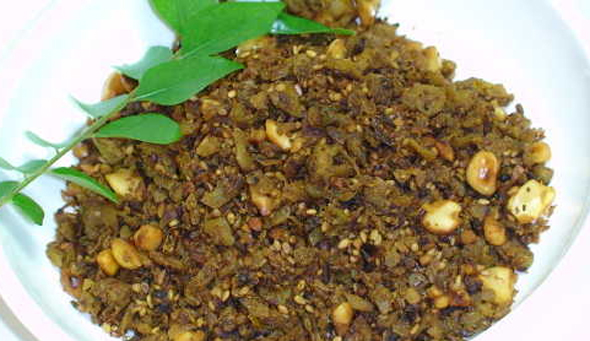Mama’s Punjabi Recipes: Karele Di Burji (Bittermelon Mash) – Quick Dish
Many people these days are looking for organic foods that are both antioxidants and can reduce certain abnormal conditions in the body, such as elevated blood sugar, which can be a precursor to diabetes; triglycerides and cholesterol, all of which can attribute to heart disease.
Although we know that bad eating habits and a sedentary lifestyle contribute to these conditions, eating the right foods can just as well positively affect the functioning of the organs of the body. For example, studies show that dark chocolate cacao flavonoids can reduce LDL and increase HDL and fish oil can reduce triglycerides. Similarly, the ingredients in karele (bitter melon or bitter gourd) have been shown to reduce blood glucose.
Most of the medicinal and antioxidant benefits of karele comes from the green exterior skin as well as the juice extracted from the bitter tasting vegetable. Some companies even sell gel capsules made of the karela extract. Karela is one of the few vegetables you can cook and eat entirely; seeds, peels and all! The Chinese variety of karela is much bigger and not as bitter or tasty for Indian cuisine.
Karele ki bhurji (bitter melon mash) uses just the exterior skin of the karela which has the most bitter taste and is the most beneficial. Because of the exterior skin is made of veins and undulations, it usually doesn’t come off in one layer but crumbles as its is scrapped off. It can also be used to make paranthas. For those on salt restricted diets, amchoor (dried green mango powder) and dahi can substitute for the salt flavor.
Ingredients:
• 5 medium karele (bitter melon) – choose green ones and not too fat
• 2 tbsp tael (vegetable oil) – use olive oil if you desire
• 1/2 cup dahi (plain yogurt) 2 tbsp pani (water)
• 1 medium piyaaz (onion) -peeled and sliced
• Spices to taste: namak (salt), mirch (red pepper), haldi (turmeric), amchoor (green mango powder) and sukha dhania powder (dried coriander seed powder)
Directions:
1. Wash the karele well then dry lightly.
2. Scrape off the karele skin. Keep the peeled karela aside to make stuffed masala bharva karele.
3. Heat the oil in a karahi (wok) and pour the scraped peels and the onions in at once. Brown both and then add the spices. Stir until the mixture starts to get a little crispy.
4. Pour in the yogurt and the water, stir and cover the wok for ten minutes.
5. Serve with hot roti. This recipe tastes better when it is a bit crispy.
MAMA’S TIP OF THE WEEK
Growing Karele In Home Garden
It seems like many homeowner have some sort of home garden or strip of land where they grow their favorite vegetables. Every year I also grow bhindi (okra) and karele in a long strip of earth facing west and usually I get a fairly decent crop that lasts us through the end of summer.
For those growing vine crops, like karelas, it is important to make sure that tiny snails do not climb up the leaves and infest them. The best thing to do is scatter slug control granules of at the roots, and then check the leaves to dislodge any snails. Also, as winters are mild in the South, remember to protect the roots as the vines will regenerate and produce a stronger and more plentiful crop the following year. Do not pull out the vines, though, by February, you can trim the runners and leaves that have become shriveled up.

Shakuntla Malhotra is a skilled cook of Punjabi dishes made in the old-fashioned style that she learnt as a young woman in her ancestral home in Lyallpur (since renamed Faisalabad), India before it became part of Pakistan after the Partition in 1947. People have often admired her cooking for its simplicity and taste that comes with each mouthful. Even in her mid-eighties, she continues to cook daily and agreed to share some of her delectable Punjabi recipes.

